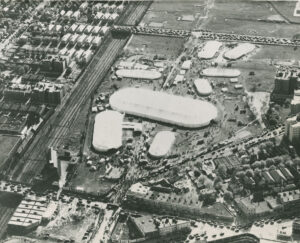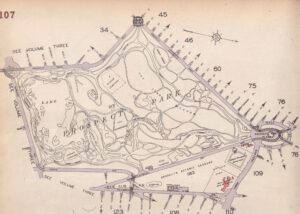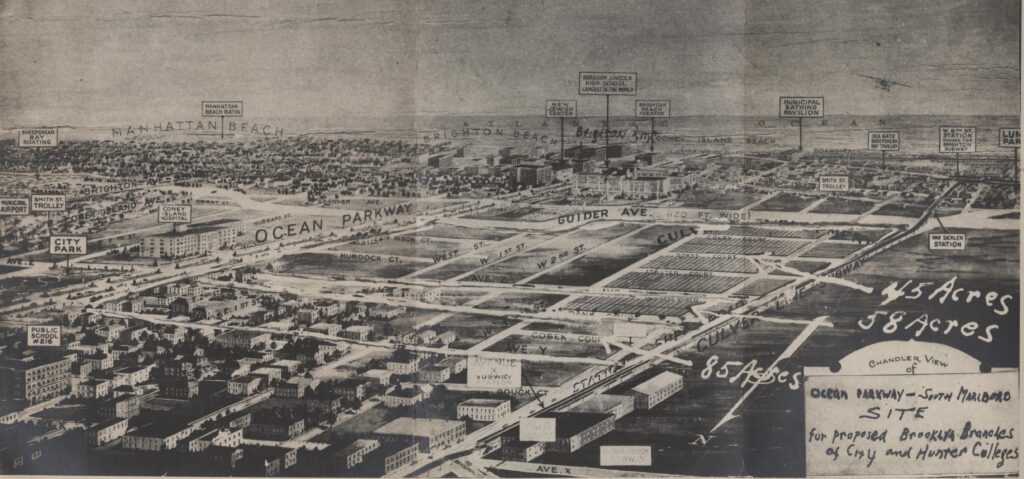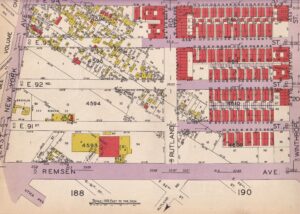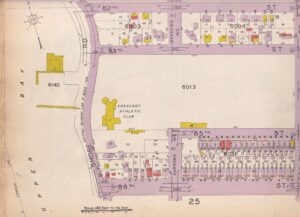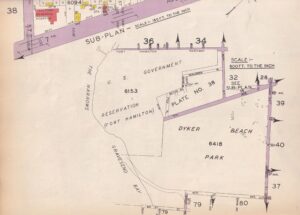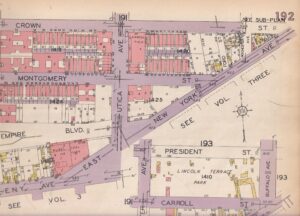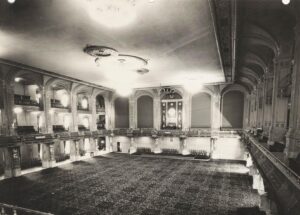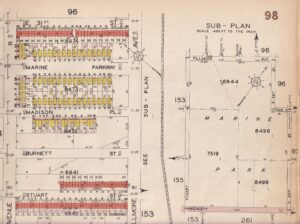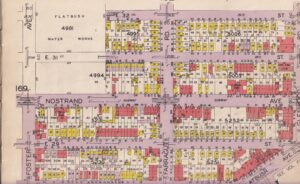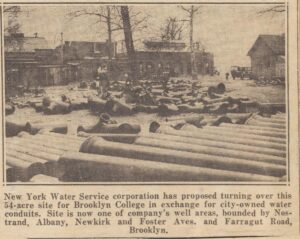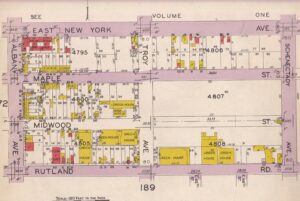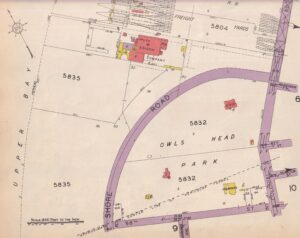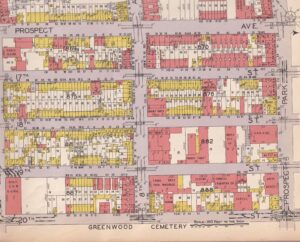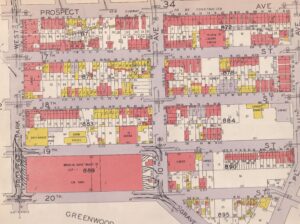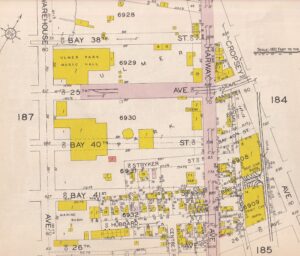In 1931 Moses J. Strook, the first Chairman of the Board of Higher Education, stated that the Board spent five years studying 40 sites to pick one. 1 We have uncovered 27. If you know one that we have missed, email [email protected].
The Wood-Harmon site was ultimately chosen for Brooklyn College. The other top contenders included the Prospect Park Reservoir, land on Ocean Parkway near Lincoln High School, and waterfront property in Bensonhurst along Gravesend Bay.
Note: All of the map images are from The Desk Atlas of Brooklyn, E. Belcher Hyde Map Company, 1929.
Wood-Harmon
The approximately 43-acre property was owned by the Greater New York Development Company, a subsidiary of the Harmon Corporation. It was originally part of a larger tract of land that the company decided to set aside as a golf course instead of using for residential housing. The aptly named “Old Flatbush Golf Course,” was a profitable venture until the city ran Bedford Avenue through the middle of the property. Afterward, Harmon rented the land to the Ringling Brothers Circus. 2
The price for the property in 1929 was $4.75 million. The city bought the property in 1935 for $1.6 million.
Prospect Park Reservoir (Mount Prospect Park)
In 1928, the Board of Higher Education selected the Prospect Park Reservoir as the site for Brooklyn College. City approval was denied once it was learned that the Reservoir would be needed for six more years until Catskill pipelines were completed. 3 Supporters of this site never gave up and their chances increased when in 1934 the Department of Water Supply, Gas, and Electricity released the Reservoir to the city.
Despite the land being free, the location was small: 8 to 10 acres, with the surrounding land already given to the Botanic Gardens, the Brooklyn Museum, and the Brooklyn Public Library. Robert Moses eyed the location for a public park. 4
Those favoring the Reservoir argued that the land given to the other institutions should be returned to the city for the college. Maurice Deutsch, a vocal architect and engineer from Long Island, sent Comptroller Joseph McGoldrick a detailed plan for the reservoir, even advocating that the college claim the unfinished Grand Army Plaza Library and transform it into a 15 story college building. That, he argued, plus the land taken from the other institutions would give Brooklyn College a large campus and room to grow. 5
For more on the history of the Reservoir and information on how the area is used today go to https://www.nycgovparks.org/parks/mount-prospect-park/history
Ocean Parkway
This large 85-acre plot was located between Avenue Y and Ocean Avenue and extended to Avenue C and Guilder Avenue. The owners proposed that the city could use the entire parcel, or it could be cut into a 58 or 48-acre site. The price in 1930: 85 acres for $1.3 million; 58 acres for $550,000; and 45 acres for $336,320.6
Bensonhurst along Gravesend Bay
The exact size of this location along Gravesend Bay from 21st Avenue to Bay 19th Street is difficult to measure since most of it was still underwater. Estimates include 25 acres of dry land and 35 to 57 acres in the Bay. Most of the land was owned by the Hengar Corporation but Mr. Gerd Henjes, who owned a one-acre a coal yard on the proposed site, argued that the cost to the city would be prohibitive as millions would be needed just to reclaim the land still underwater. Those who favored the location also proposed purchasing a five-acre plot owned by the Children’s Aid Society.
In September 1931, the Brooklyn Daily Eagle reported that the owners wanted $850,000 for the property. 7
Ash Removal Location
This approximately one city block ash removal site was located on Remsen and East New York Avenues. 8
Canarsie
This 54-acre tract of land was bounded by Rockaway Parkway and East 105th Street, between Avenues J and L and on both sides of Avenue K. 9
Crescent Club in Bay Ridge
Members of the Board of Higher Education felt the 15-acre site selling for $1.5 million was too small for the college. 10
Dyker Beach Park
The idea of using city-owned parkland was not limited to Prospect Park and Dyker was one of a handful of Brooklyn parks brought to the Board of Higher Education’s attention. This park is located at 86th Street and 7th Avenue. 11
East New York
This irregular plot, consisting of 495 city lots (approximately 22 acres), was located between East New York, Utica, and Remsen Avenues 12
Elks Club
This location at Livingston Street and Boerum Place boasted an indoor pool and a beautiful ballroom. It was quickly ruled out as too costly to renovate and too small as the space calculated by the owners included sub-basements and corridors which could not be used for classrooms. 13
- The Elks Club. Records of the Office of the President, Brooklyn College Archives.
- Elks Club Ball Room. Records of the Office of the President, Brooklyn College Archives.
New Flatbush-Harkness Estates
While parts of this property had already been sold for residential use, the land was available in two 53-acre tracts each selling for $1.6 million. One of the two tracts was bounded by Avenues V and X between Coyle and Haring Streets; and the other by Avenues V and X between Bedford Avenue and East 29th Street. Advocates proposed that nearby Marine Park could be used for athletics. 14
City-Owned Property on Flatbush by the Barren Island Airport
While the Flatbush Chamber of Commerce favored Wood-Harmon, this location on the west side of Flatbush Avenue opposite the Barren Island Airport, was their second choice.15
Fort Hamilton
Proponents of this site argued that since the big guns had been removed and the property was only being used for drills and residences, perhaps the Army would close the base: “There is a widespread belief that sooner or later the Federal Government will abandon this location.” 16
House of the Good Shepherd
This property on Hopkinson Avenue and Pacific Street was considered too small and remote by the Board of Higher Education. 17
The “Jungle”
The Downtown Brooklyn Property Owner’s League called for the condemnation and clearance of 35 city blocks near the Navy Yard which they dubbed “the jungle.” Their main reason: vice clearance: “If this property is taken over by the City and used as a college site, the evil rampant in this area would be wiped out at once.” 18
Land between the approaches to Brooklyn and Manhattan Bridges
This area was viewed as too congested by the members of the Board of Higher Education.19
Marine Park
This park is bounded by Avenue U and Fillmore Avenue from Stuart Street to East 33rd Street. 20
New York Water Services Corporation Site
This location consisted of 54 acres bounded by Nostrand, Albany, Newkirk, and Foster Avenues.21
- Image of the Water Works from the Brooklyn College Scrapbook Collection. Brooklyn College Archives.
Old Boys High Field
This location at Troy and Schenectady Avenues was purchased by the Board of Education in 1928. 22
Old Stone House at Gowanus
This proposal included the Old Stone House and one block immediately to the south. 23
Owls Head Park
This 24-acre park is located on Colonial Road and 68th Street in Bay Ridge. 24
Polytechnic Building
The Polytechnic Building on Court and Livingston Street was ruled too small by the Board of Higher Education with only 50,000 square feet available for college purposes. Modernizing and bringing the 2 parts of the building (built in 1855 and 1889 respectively) up to fire code would have been too costly. 25
- Partial Clipping from the Brooklyn College Scrapbook Collection showing the Polytechnic Building. Brooklyn College Archives.
66 Court Street
Brooklyn College was already renting six floors in this building as part of the Downtown Campus. The owners were selling the property for $850,000.
Skyscraper at the Site of the lower Fulton Street Elevated Train
This idea was proposed by Stewart Browne, President of the United Real Estate Owners Association, at the June 9, 1931 meeting of the Board of Estimate. Since the El was going to be torn down, Browne argued that it would be a perfect site for the college and a civic center. The land between Fulton, Washington, and Sands Streets would have to be condemned, giving the city 11 acres. 27
South Brooklyn Site
This location consisted of 8 blocks opposite Green-Wood Cemetery, bounded by 8th and 10th Avenues and 20th Street and Prospect Avenue. 28
Ulmer Park
While large, this location in Bath Beach was viewed as too remote by the Board of Higher Education. 29
Two blocks of Avenue V
This location was mentioned in a 1931 Brooklyn Daily Eagle article. Herman Bernard, the owner of part of this property, stated that he and the other owners were ready to sell their lots to the city for Brooklyn College. However, the cross streets were not mentioned. 30
Endnotes
1 “Acts to Pick Site for College in Kings,” New York Times 10 June 31:26.
2 Letter from Randolph Evans to Dean Thomas Coulton, 1952. Papers of Murray Horowitz. Brooklyn College Archives and Special Collections.
3 “Mt Prospect Reservoir as School Site Denied,” Brooklyn Daily Eagle 2 July 1929: 19; Documents Pertaining to the Prospect Park Reservoir. Box 1, Folder 1. Construction of the Midwood Campus. Brooklyn College Archives and Special Collections.
4 “Library Trustees Assail College Site,” Brooklyn Daily Eagle 28 March 1934: 32; “Moses Studies Reservoir Site,” Brooklyn Daily Eagle 30 March 1934: 3; “Disadvantages of the Reservoir Site. “ Box 1, Folder 1. Construction of the Midwood Campus. Brooklyn College Archives and Special Collections.
5 Letter and Report from Maurice Deutsch to Comptroller Joseph McGoldrick Re: Proposed Brooklyn College, May 17, 1934. Box 1, Folder 1. Construction of the Midwood Campus. Brooklyn College Archives and Special Collections.
6 “Brief on the Behalf of the Proponents of the Property Known As The Ocean Parkway-Marboro Site” Box 1, Folder 1. Construction of the Midwood Campus. Brooklyn College Archives and Special Collections
7 “Millions needed to improve site declares Henjes,” Brooklyn Daily Eagle 20 January 1931: 28; “Chief Obstacle on College Site,” Brooklyn Daily Eagle 18 January 1931: 3; “Bensonhurst Site Cut to $850,000,” Brooklyn Daily Eagle 12 September 1931:1.
8 ”Dyker Beach Park Latest College Site,” Brooklyn Times January 13 1931.
9 “Three New Bus Routes Asked for Erie Basin” Brooklyn Daily Eagle 1 December 1934: 3.
10 “Crescent Club Gets Option,” Brooklyn Daily Eagle 6 April 1930: 1; “Crescent Club Land Considered As College Site,” Brooklyn Daily Eagle 5 March 1930: 13.
11 ”Dyker Beach Park Latest College Site,” Brooklyn Times January 13 1931.
12 “All College Site Bids too High,” Brooklyn Daily Eagle 1 September 1931: 3.
13 Letter from Edwin Thatcher, Commissioner of Buildings to Borough of Brooklyn to Ingersoll, May 24, 1924. Box 1, Folder 1. Construction of the Midwood Campus. Brooklyn College Archives and Special Collections; Letter from Mark Eisner, Chair of the BHE to Commissioners of the Sinking Fund, March 12, 1934 Box 1, Folder 4. Construction of the Midwood Campus. Brooklyn College Archives and Special Collections; “Reopen College Site Question,” Brooklyn Daily Eagle 28 February 1934: 1.
14 “Harkness Tract Advocates Ask for Brooklyn College,” clipping, undated. Brooklyn College Scrapbooks. Brooklyn College Archives and Special Collections.
15 “Flatbush C of C Board Rejects Harmon Tract,” Brooklyn Daily Eagle 20 February 1930: 4; “Flatbush Chamber Favors Harmon Site for College,” Brooklyn Daily Eagle 21 Feb 1930: 2.
16 ”Dyker Beach Park Latest College Site,” Brooklyn Times January 13 1931.
17 ”Dyker Beach Park Latest College Site,” Brooklyn Times January 13 1931.
18 Letter to Mayor LaGuardia from the Downtown Brooklyn Property Owner’s League. Box 673, Folder 1 Records of the Office of The President. Brooklyn College Archives and Special Collections.
19 ”Dyker Beach Park Latest College Site,” Brooklyn Times January 13 1931.
20 ”Dyker Beach Park Latest College Site,” Brooklyn Times January 13 1931.
21 “Dietz checking on Water Site for College,” Brooklyn Daily Eagle 22 August 1933: 8.
22 “Few Respond to City’s Plea in Site Muddle,” Brooklyn Daily Eagle 17 June 1931: 19.
23 ”Dyker Beach Park Latest College Site,” Brooklyn Times January 13 1931.
24 “Few Respond to City’s Plea in Site Muddle,” Brooklyn Daily Eagle 17 June 1931: 19.
25 Letter from Mark Eisner, Chair of the BHE to Commissioners of the Sinking Fund, March 12, 1934 Box 1, Folder 4. Construction of the Midwood Campus. Brooklyn College Archives and Special Collections.26
“Mayor Visions 5 Million for Brooklyn College,” Brooklyn Daily Eagle 21 May 35: 9.
27 “B’klyn College in Skyscraper Lures Mayor” Brooklyn Daily Eagle 9 June 31: 1; “Seeks Loan for College” Brooklyn Daily Eagle 14 June 1934: 1.
28 Dyker Beach Park Latest College Site,” Brooklyn Times January 13 1931.
29 Dyker Beach Park Latest College Site,” Brooklyn Times January 13 1931.
30 “Few Respond to City’s Plea in Site Muddle,” Brooklyn Daily Eagle 17 June 1931: 19.

